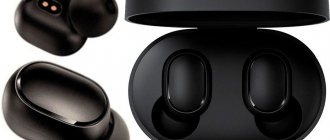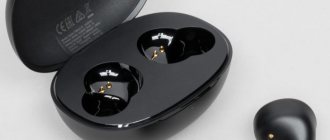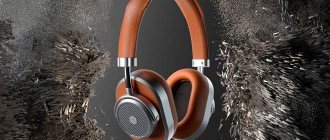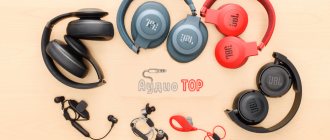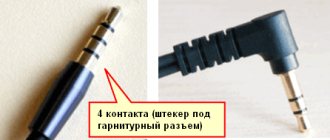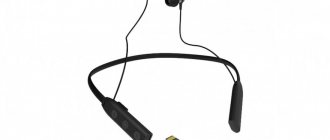Pay attention to the IP rating
"Waterproof" is a flexible term, and "water-repellent" is an even more flexible term. To receive such adjectives in its description, a device must pass a standardized test to determine its level of protection against liquids. The result is called the “Ingress Protection ( IP ) Rating.
Briefly we can say the following. Manufacturers scrupulously test their products based on a strict system of recommendations. The level of water protection is given a numbered rating. However, the IP rating also includes dust resistance, which can be confusing.
Let some headphones be rated IP57 and others IPX7. Which ones are better protected from water and what does the X mean? Their level of water resistance is essentially the same. This level is shown by the second digit in the IP rating, in this case it is 7. The first digit shows dust protection and the first model has dust resistance level 5.
The second model of headphones did not pass tests for dust protection, so there is an X there. This is just a plug so as not to put a zero, because there is still some kind of dust protection.
Headphone manufacturers often do not test for dust resistance, which is why the rating is X.
Most people don't need headphones with serious water protection. Headphones may have more desirable features, such as active noise cancellation or a customizable equalizer.
Swim to music: Aftershokz XTrainerz headphones-player for swimming
This year, Aftershokz is outright star-studded.
Firstly, they became part of the Marvel Cinematic Universe: it was with the help of the Trekz AIR model (the flagship at that time) that Mysterio launched drones and gave commands in Spider-Man: Far From Home.
No, seriously, we ourselves didn’t believe it at first, but then as we brought it closer, it just took pride: it’s not otherwise that the guys from Marvel read our reviews on IXBT... (smiley).
Secondly, 3 new products were presented, two of which were released. The “cinema” AIRs were replaced by the improved Aeropex model. And thirdly, we got a new category of users - swimming enthusiasts, because we got a new product - the XTrainerz waterproof player. I wanted to talk about him.
The trick is basically that Aeropex and XTrainerz are cast from the same mold, and are essentially the same model with slightly different characteristics. The main difference is the water resistance index and the presence/absence of Bluetooth.
XTrainerz is a player with built-in memory of 4 GB , and it cannot connect to a smartphone.
Whether this is good or bad, I don’t have a definite answer. On the one hand, it doesn’t matter, because Bluetooth won’t work in water anyway. On the other hand, it’s bad because it’s not just water. Finally, this may be a good thing, considering the following. Previous generations of Aftershokz versions were criticized for their sound, part of the problems with which were precisely Bluetooth compression and an insufficiently modern codec.
Here we don’t seem to depend on any compression, but the supported formats are: MP3, WAV, WMA, AAC, FLAC. I went on vacation with the XTrainerz, and over the course of a few weeks I was able to listen to them, swim in them, and listen to them while swimming. I will share my observations.
Ease of use
Despite the fact that the body can be said to be inherited from the previous model - AIR - the speaker has been redesigned quite smartly.
This affected the fact that, firstly, it fits tighter and better to the head, and, secondly, it affected the overall weight of the headphones: they became even less noticeable on the head, so there are no complaints about the fit, and the headphones can be find it convenient. The body is designed according to the same “titanium” model: the headband arc is flexible and strong.
In terms of size, they are universal and, as they would say on the market, “stretch” perfectly.
In my scenario - lying on the water with a mask - there were no problems either. The model gets along well with other devices on the head.
But I didn’t really manage to dive into them. From the experience that I had, nothing illogical is observed: if you jump with a “bomb”, the headphones will be knocked off your head. If you jump as a fish from a height somewhere on the side of the pool, then your ears become an obstacle, and XTrainerz holds on.
Headphones on the beach
One of the questions I asked myself sounded quite simple: is it necessary? Here it is appropriate to divide the use of such gadgets into salt water and fresh water. During my stay on the coast, I saw a lot of people with players, others - damn them - with portable speakers, etc. In general, a person’s need for musical accompaniment seemed to have emerged, and I’m sure that if all players were waterproof , then vacationers would not take them off in the water.
As for XTrainerz as headphones for the pool, then you should ask the professionals: in general, motivating music is probably appropriate at a distance, as well as during running. And the same Wordstat shows some interest and need. Swimming headphones:
Pool Headphones:
What does the new model sound like?
New models are praised for their sound. As a not very experienced person, I don’t feel much difference at all between, say, XTrainerz and regular headphones.
A number of reviews describe the new speakers as capable of "crystal clear highs and mids with real bass." This is explained, among other things, by the fact that we ourselves can now hear better: the new speakers fit tightly and completely flat to the skull, which distributes sound evenly and fully.
At the same time, the headphones sound louder than their predecessor. This moment, by the way, is interesting. The fact is that in the AIR model the sound was slightly artificially reduced due to the fact that users were outraged by the vibration. Reducing the volume made it possible to significantly reduce this figure.
In XTrainerz, we have even less noticeable vibration with louder sound, and it was really noticeable! The second “moment” of the new speakers that is worth noting is sound leakage. If in previous versions the sound leakage was compensated by antiphase from special holes, here there are no holes on the body. At the same time, the sound is hardly audible to a stranger at a volume that is comfortable for you.
In general, both sound and leakage are, of course, important issues, but controversial. Firstly, how many people will actually make audiophile demands on headphones in the water while swimming? And how many people will be afraid of being “overheard” during a swim? In my opinion (rumor), Aftershokz did it well in this version.
Open ears on/underwater
The main feature of bone conduction is that the ears remain open. From the point of view of water safety, this may be logical: both in the pool and in open water on a common beach, for example, you can bump into someone, not hear someone, a trainer/instructor/lifeguard. That is, there seems to be no need to completely lose coordination.
Another thing is that some waterproof plugs will additionally protect you from water leakage. Here we can only note that the XTrainerz comes with a pair of silicone earplugs.
Controls
Since this is an independent player, the controls have changed slightly. For example, for this reason we lost the call answer button on one of the speakers.
The main buttons are located on the battery: power-on-volume-tracks.
Also in this version we got one additional button - something like an equalizer, which slightly changes the sound: you can change the mode depending on how deep underwater you plan to listen to music.
Autonomy
The headphones last a long time. With new ones out of the box, the situation is generally excellent: I turned it on at noon and turned it off at midnight. With continuous playback - initially 12 hours - this is the normal life cycle of the battery.
That is, if you use them during swims and training, they will last for a long time. In this version, by the way, the charging method has changed: now the model is charged from its “dock”.
The docking station itself is powered by a Micro USB cable. The charging connectors look like this:
Brief summary
The XTrainerz model, like the entire Aftershokz range, is positioned as a sports model, but this time it is aimed at a new audience: swimmers should join the ranks of runners and cyclists.
My experience was positive: they satisfy me in terms of sound, in terms of comfort and “compatibility” with the mask, too, and listening to music out of boredom while you swim, even for 15-20 minutes, is a pretty good bonus.
What I was missing was Bluetooth, because I would like a much more versatile device, and not just a player with water protection. Such a device is the Aeropex model, which, by the way, loses in only one IP point: Aeropex IP67 protection versus IP68 from XTrainerz.
More information about XTrainerz can be found on our website. We have additionally placed the entire Aftershokz assortment on a separate website.
Waterproof headphones for swimming
Bluetooth connectivity doesn't work very well underwater. IPX7 rated wireless headphones may seem like an attractive purchase, but you may end up with no or intermittent signal.
There are manufacturers that specialize in Bluetooth swimming devices, like H2O Audio . These devices are designed so that the element receiving the signals is above the water. Regular headphones end up in water every time you lift your head to breathe.
Range is another issue when using headphones when swimming. The Bluetooth signal source must be close, otherwise there will be no sound. Ultimately, listening to sound through wireless headphones while swimming is possible, but the headphones described in this article are not intended for this.
What is the difference between regular headphones and special ones for swimming?
Waterproof headphones have their own specifics:
- Most of them use Bluetooth to connect to a smartphone. There are also models that already have a built-in mp3 player; in this case, control is carried out through a special “finger” remote control.
- Headphones for swimming are usually in-ear devices. Due to the fact that they close the ear canal, the proper level of hydro- and sound insulation is ensured.
- “Underwater” devices are fixed as tightly as possible in the auricle, giving the user complete freedom of action. They are virtually maintenance-free and do not require any maintenance.
- Waterproof headphones are lightweight and have the most ergonomic, anatomical design. Many of them are equipped with special clips that help hold the device in a certain position.
- In online stores you can find swimming headsets that use bone conduction technology. The peculiarity of these models is that the speaker is located opposite the cheekbone, and the sound is perceived by the inner ear.
There is still a fly in the ointment in this huge barrel of honey: despite all the advantages and some advantages over conventional devices, waterproof models also have disadvantages. First of all, this is the sound quality. Pool headphones are inferior to standard ones in this criterion. This is primarily due to audio transmission technology: Bluetooth degrades and distorts the signal.
Charging waterproof headphones
For a number of reasons, there are more physical activity headphones than over-ear and in-ear headphones. In-ear headphones include truly wireless headphones and more traditional wireless models with a cable.
True wireless headphones are becoming more common and have charging cases. Typically, the protection rating listed applies only to the headphones and not to the cases. Cases most often do not have protection against water. Some charger cases have a waterproof outer surface, but have not yet come across an internal waterproof part.
If you place wet headphones in this charging case, it may damage them.
Wireless headphones with a cable do not have this problem. These headphones often have secure charging ports. The fine print states that the waterproof rating is not considered when the cover of this port is not closed.
In general, water-resistant headphones and waterproof headphones are sufficient, but you need to be careful when charging. The headphones are not waterproof while charging, so make sure they are dry before connecting them to the cable or placing them in the charging case.
top 10
On a note. Wireless waterproof sports headphones are used for active training in the gym or outdoor stadium. They can withstand heavy sweat and precipitation, but manufacturers do not recommend taking a shower or swimming in them. The same rule applies to waterproof TWS headphones.
For scuba diving, training and swimming in reservoirs, it is preferable to choose special “ears” - a player for the pool. We present a selection of the best headphones for swimming.
JBL Endurance Sprint
Waterproof headset rated IPX7. The affordable device is made in the format of in-channel “ears” on the collar. Communication with the sound source via Bluetooth. For a secure fit inside the ear, Endurance Sprint is equipped with ear pads made of special FlexSoft material and comfortable ear cushions. The battery life of the gadget is up to 8 hours. Swimming in the pool is allowed without immersing your head in the water.
Mifo O5
TWS headphones for swimming in the pool are characterized by the complete absence of wires. Wireless bluetooth plugs are recharged in the charging case, which is included in the kit. The manufacturer also supplies 7 pairs of replaceable ear pads with the headphones. The range of Bluetooth connection v5.0 is 20 meters. Protection class IP67. The device can be used for swimming in a pool or pond, provided there is no need to immerse your head in water.
Plantronics Backbeat Fit
Universal waterproof bluetooth headphones on a collar with backlight. Can be used for active training in nature and swimming in a pond/pool without immersing your head in water. IP57 waterproof rating supported. They can be simultaneously connected to several sound sources and quickly switch between them. A significant disadvantage is the outdated version of Bluetooth 3.0.
Elari Nanopods Sport
You can use these bluetooth headphones for swimming without putting your head in the water. The form factor of the device is waterproof Bluetooth plugs that meet the IP67 protection class. Elari Nanopods Sport operate using the bluetooth v 5.0 protocol. Charging case included. They do not differ in long-term autonomy; they last up to 3.5 hours before recharging.
JBL Endurance Peak
A universal device for an active lifestyle. This model of wireless headphones can withstand swimming without being completely submerged in water thanks to IPX7 water protection. The accessory is distinguished by high-quality materials, reliable fastening of the plugs using proprietary TwistLock&FlexSoft technologies and an extended frequency range of 16-22000 Hz. Charging case included.
Plantronics Backbeat Fit 3100
Waterproof Bluetooth headphones are positioned as a convenient sports accessory. An earhook mount is provided. The earplugs look stylish in the ear. After an intense run, you can swim in them in the pool, keeping your head on the water. The gadget operates using the Bluetooth 5.0 protocol.
Jabra sport
Bluetooth headset with IP67 waterproof properties. Calm swimming is allowed without immersing your head in the water. The device is equipped with a built-in FM radio and the Endomondo Sports Tracker application, which informs about the distance covered, speed and time spent. Among the shortcomings is an outdated bluetooth 3.0 communication module/
JBL Reflect Flow
Completely wireless “ears”-plugs are equipped with moisture protection of the IPX7 standard. The gadget runs on the current version of bluetooth v 5.0. Can be used for indoor and outdoor training, as well as in the pool, provided there is no need to dive under water. These are not underwater headphones; you cannot dive with them.
Sony NW WS625
Wireless waterproof headphones-player from Sony can be used for full training in the pool. Sony headphones have a high degree of moisture protection - IPx68, and can withstand immersion to a depth of 2 meters for 30 minutes. For sound reproduction in water, a built-in 16 GB mp-3 player is used, where you can upload a lot of your favorite musical compositions.
Apple's only waterproof headphones: Apple AirPods Pro
They have excellent noise reduction and high-quality sound, as well as an IPX4 rating.
pros
- High sound quality
- High level of active noise cancellation
- Fit securely in ears
- Hands-free use of Siri
- There is a case for wireless charging
- Splash protection
Sony NWZ-WS613 and NWZ-WS615
High-quality headphones for training in the pool.
Headphones-player of the highest level with a wide range of functions and high sound quality. The headphones will be ideal not only for swimmers, but also for other athletes. The housing is waterproof and protected from salt water, and is made of high quality plastic. The only drawback is that you can dive into them to a depth of no more than 2 meters. The headband can be adjusted, making the headphones very easy to fit on any head size. It is worth noting that the color palette is wider than that of competitors and is presented in black, white and blue.
The models are equipped with a Bluetooth wireless module with an A2DP profile, which makes it possible to use them as a headset. Batteries for the battery can work efficiently for 8 hours. Another advantage is that the device is equipped with an NFC module for quickly connecting devices, as well as Clear Bass and Clear Phase.
The main difference between the older 615 model is 16 GB of internal memory (the younger model, for comparison, has only 4 GB).
The kit itself includes ear pads, chargers and micro-USB cables upon purchase. And the cool thing is that there is a small remote control ring that allows you to change songs and adjust the volume of the tracks being played.
Sony NWZ-WS613
Main characteristics
- Device type: player
- Waterproof: IPX8
- Type: Flash
- Interfaces: Bluetooth, A2DP, NFC
- Remote control: yes
- Volume: 4 / 16 GB
- Audio formats: MP3, WMA, WAV, PCM
- Working time: 7 hours
Equipment
- FINIS Duo Underwater Headphones
- Charging cable
- Remote control
- Holder
- Adjustable temple
- Ear pads for sushi and water
- Documentation
Video review
- Stylish design and thoughtful functionality
- High-quality sound with support for all popular audio formats
- You can swim in salty sea water
- Additional ear pads and remote control
- Large amount of memory on both devices
- Doesn't work with FLAC format
- The glossy body slips out of your hand
Best noise canceling in its class: Bose QuietComfort Earbuds
These headphones have IPX4 protection and the best noise cancellation of any wireless headphone tested.
pros
- Best noise canceling for headphones in this class
- Rich, clear, balanced sound
- Clear listening mode can be combined with ANC mode
- Splash protection
- Stays securely in your ears
Minuses
- High price
- Sound quality is not suitable for audiophiles
- Weighty case
- Controls could be more comprehensive
Prices for Yandex.Market
Bose Quiet Comfort Earbuds
#2 JBL Endurance SPRINT
Stylish wireless headphones for the pool with a comfortable fit on the ear will allow you to enjoy swimming to the sounds of your favorite tracks. By the way, have you heard that listening to music during training increases endurance?
- The battery life of these wireless headphones is 8 hours. They are IPX level 7 certified.
- Thanks to its comfortable and ergonomic design, the device fits well in the ear, and its light weight allows you to completely forget about the presence of technology.
- The sound quality is acceptable, the noise insulation is excellent, and the kit comes with several pairs of interchangeable ear pads of different sizes.
pros
- The signal radius is 30-40 meters, which is enough to leave your smartphone in your backpack and connect to your “ears” without interference. This way you don’t have to swim in the pool with a bulky case with a player and worry about its tightness;
- A very well-thought-out and strong fastening in the form of a bow for the auricle;
- Well-known brand and corresponding build quality;
Minuses
- Very sensitive touch button;
- Weak microphone;
- The wire between the speakers is a bit short – you can’t hang it around your neck, they might get lost;
Price:
2500rub
Best combination of cost and quality: Jabra Elite Active 75t
The original headphones have been improved with a more secure fit and waterproof design.
pros
- Powerful sound with thunderous bass and prominent highs
- Great built-in equalizer
- Water and dust protection
- Stays securely in your ears
Minuses
- Price
Prices for Yandex.Market
Jabra Elite Active 75t
Which waterproof headphones are best to buy?
When buying good headphones, you need to decide what degree of protection from moisture is needed. For swimming and complete immersion under water, the minimum rating is IP67, IPX5 allows you to wash the device under water and not be afraid of heavy rain. A lower class is protection from moisture and dust - such devices will not be damaged by light rain or random water drops.
You should also choose between wired and wireless. The former guarantee perfect communication in any conditions, but are less convenient. Models with Bluetooth modules give more freedom and are suitable for playing sports, listening to music or books in the office, or while driving.
Equally important is the battery life, which varies from 3 to 20 hours. If headphones are needed only for sports, then 3-4 hours is enough; for daily listening to music and books, models that can work for 6-9 hours are useful, even better when there is a fast charging mode.
The rating from our editors will help you choose the best waterproof headphones for any purpose. These are reliable and high-quality devices, already tested by numerous users and highly rated by experts.
Best Designed (Neckband): Jaybird X4
With a focus on physical activity, wireless headphones are quite versatile. They have powerful bass or balanced sound, depending on the equalizer settings.
pros
- Powerful audio performance that can be adjusted via the in-app equalizer
- Fits perfectly in the ears
- Waterproof
Minuses
- Short proprietary charging cable
Best when using MapMyRun: JBL UA True Wireless Flash X
Designed for exercise, the IPX7-rated JBL UA True Wireless Flash X delivers great bass and long battery life.
pros
- Powerful sound with high-quality bass
- High autonomy
- Waterproof housing
- Ambient Aware listening modes
- 12 month subscription to MapMyRun
Minuses
- Large charging case
- There is no application with equalizer and settings
Inexpensive waterproof headphones: Tribit FlyBuds 3
True wireless headphones with IPX7 protection and high-quality sound, as well as a powerful charging case.
pros
- Powerful bass and overall sound
- Autonomy and ability to charge other devices
- Price
- IPX7 protection
- Stays well in the ears, there are different tips
Minuses
- Mediocre design
- No equalizer app
Prices for Yandex.Market
Tribit FlyBuds 3
Best Waterproof On-Ear Headphones: Adidas RPT-01 Sport On-Ear
They produce sound with serious bass and are suitable for physical activity. The overlay design will match the rest of your sports gear.
pros
- Bass-focused sound
- Stylish, sporty design
- Intuitive on-ear controls
- Removable ear pads are washable
Minuses
- The sound is not up to audiophile requirements
Prices for Yandex.Market
Adidas RPT-01 Sport On-Ear
Best with equalizer settings: Jaybird Vista
These true wireless headphones deliver powerful sound and are suitable for the gym. The equalizer allows you to customize the sound as you wish.
pros
- High-quality sound with strong bass and clear highs
- Equalizer in the application
- IPX7 protection
- Stays securely in your ears during exercise
Minuses
- Limited controls on the earpiece


